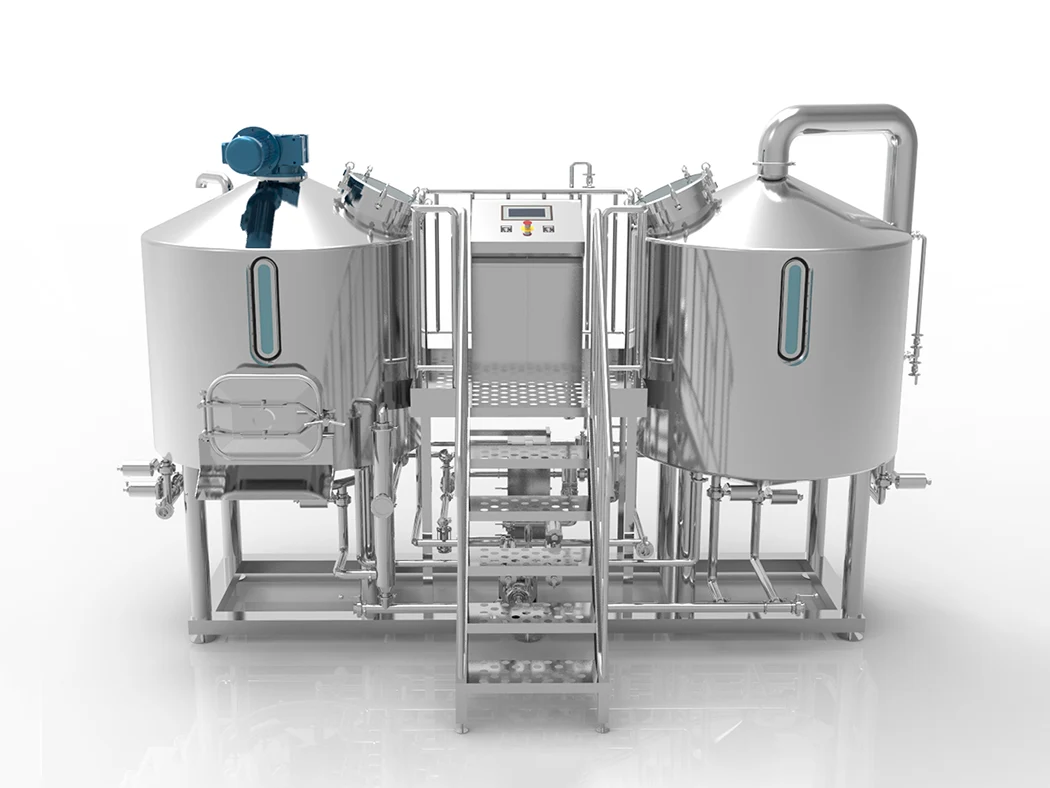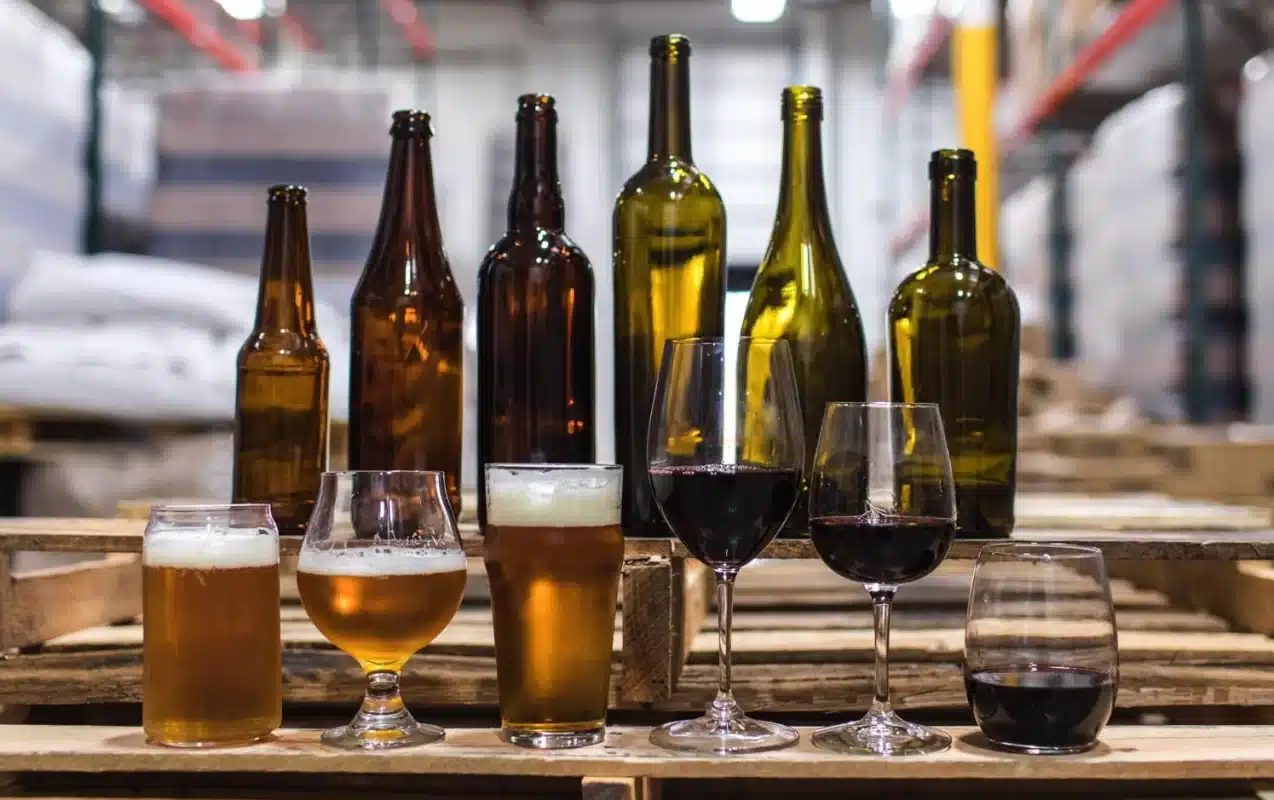You crush great fruit but lose quality to dirty gear, hot ferments, and oxygen burn. Labor rises. Flavor falls. Margins shrink. Switch to a stainless steel tank program and take back control – clean, repeatable, profitable winemaking.
To ferment wine in a stainless steel tank, deep‑clean and sanitize the vessel, chill and adjust your grape must, inoculate with healthy yeast, and lock in temperature control at the target range. Track Brix, temperature, and aroma daily; protect headspace with inert gas. When fermentation reaches dryness, rack, stabilize, and clarify. Stainless steel keeps things clean and minimizes oxidation.
Below is your step‑by‑step guide. I will show you what is happening inside the stainless wall, how to plan the fermentation process, how to clean the tank fast, and how to size equipment for growth. We will compare oak barrels, talk temperature control, and walk through common problems. By the end, you can ferment wine with confidence – whether you run a 500‑liter pilot cellar or a multi‑site winery.
1. Why Stainless Steel Tanks Are Ideal for Wine Fermentation
If you want good wine that repeats vintage after vintage, control beats romance. A stainless steel tank gives you control. Wood breathes. Concrete sheds heat slowly. Plastic stains. Stainless stays neutral, sealed, and predictable.
Here are the key factors that matter when you compare vessels in real cellar life:
| Key Factors | Stainless Steel | Oak Barrels | Plastic / Other |
|---|---|---|---|
| Flavor input | None – pure fruit | Vanilla, toast | None / plastic taint risk |
| Temperature control | Cooling jacket + sensors | Ambient only | Limited |
| Oxygen exposure | Tight welds; low | Slow seep | Variable |
| Cleaning effort | Spray ball, easy to clean | Hand work | Can scratch |
| Corrosion resistance | High (316L) | N/A wood | Varies |
| Scaling batch size | Simple (up to 200 kL) | 225 L each | Small |
High-quality Stainless steel prevents large swings in fermentation temperature because tanks are equipped with a cooling jacket plumbed to glycol. With sensors tied to a controller, you can control fermentation precisely, whether you are making a crisp white lot, a fruit‑driven rosé, or a robust red wine cap‑managed on skins.
Why else do tanks offer such value? Stainless steel tanks provide less maintenance over time. Welded seams are smooth, so you simplify the cleaning routine, minimize bacterial growth, and reduce chemical usage. Compared with wooden barrels that demand topping and sulfuring, stainless saves labor.
Mini Case: One startup in Oregon ran side‑by‑side lots – Pinot in two oak barrels and Pinot in a 1,000 L stainless fermentation tank with cooling. The stainless lot held fruit better (lower volatile acidity, brighter cherry). The wood lots showed more tannin but also more variation. Blending both gave the final wine a lift. Tanks can also coexist with barrels; you do not have to choose all or nothing.
Learn more about full cellar layouts and wine making equipment in manufacturing line: wine making equipment .
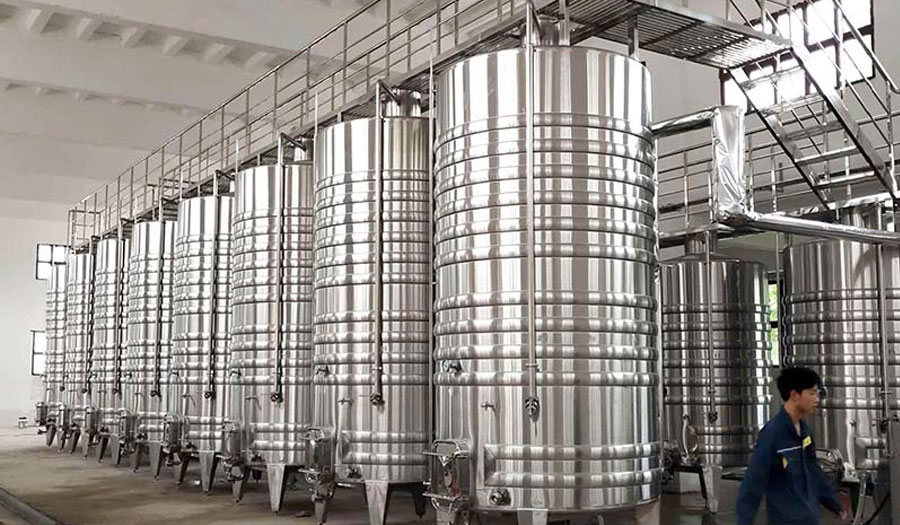
2. What Happens Inside the Fermentation Process – Yeast, Alcohol, Heat, and Pressure
At its core, wine fermentation is yeast turning grape juice into alcohol and carbon dioxide. Sounds simple. Real tanks make it safer.
During peak activity, the yeast population doubles fast. Sugar drops. Heat rises. Foam builds. If you cannot remove that heat, aromas cook off and color shifts. A jacketed stainless steel tank lets you pull heat away. That is why stainless steel tanks are generally preferred for aromatic varieties and fresh styles where you want the flavor of the wine to stay bright.
Let us look at the basic curve:
- Lag phase – yeast wake up; little heat.
- Exponential phase – big sugar drop; lots of alcohol and carbon dioxide; monitor closely.
- Slow finish – polish off remaining sugar; settle solids.
Because stainless steel is smooth and inert, you get fewer nooks for bacterial growth. That helps you make wine with lower sulfur additions. It also helps when you move from beer and wine crossover production in mixed facilities; a clean stainless surface does not hold hop oils or Brett the way wooden barrels might.
Remember: fermentation generates heat from the bottom of the tank upward. Larger diameter = more heat retention. Use stainless steel cooling zones around the tank wall to keep the core cool.
3. Preparing and Sanitizing the Stainless Steel Wine Tank Before Crush
Clean gear makes clean wine. Here is a fast, cellar‑tested prep that works across small pilot tanks and 50 kL commercial units.
Step 1. Rinse Flush debris with warm water at moderate pressure. Check the bottom of the tank and manway gaskets.
Step 2. Detergent Wash Use an alkaline cleaner at label rate. Recirculate through the spray ball 10 to 20 minutes. Scrub valves. Do not forget the sample port.
Step 3. Acid Rinse and Passivate Citric or nitric blends brighten the surface and rebuild the chromium layer that gives stainless its corrosion resistance. This matters most for new welds and after long acid soaks.
Step 4. Sanitize the Tank Peracetic acid (PAA) fog or soak. Minimum 10 minutes contact. Drain but do not rinse if within spec. Seal the tank closed‑top to keep out dust and fruit flies.
Step 5. Pre‑Chill (Optional) If you plan cold soaks on red lots, drop the jacket to 10 °C before filling.
When you fill, leave headspace for cap rise. Tanks are usually filled to 70–85 percent for red lots on skins and closer to 95 percent for pressed white musts. If you must vary the volume of wine, deploy an internal floating lid and gas the headspace.
Explore jacketed designs, cone angles, and variable capacity options in our stainless steel fermenter range.
4. Temperature Control: Dialing In Flavor, Color, and Texture
Temperature control during fermentation is the number one tool you gain when you use stainless steel. A good controller lets you hold Sauvignon Blanc cool for crisp acids, push a warm ferment on Syrah skins, or slow a sluggish lot.
Target Ranges (general cellar practice):
| Style | Target Fermentation Temperature | Notes |
| Aromatic white wine | 14–18 °C | Preserve esters; low oxygen exposure |
| Rosé | 15–18 °C | Light color; fruit forward |
| Red wine (skin contact) | 24–28 °C | Extract color; watch cap |
How it works: the cooling jacket wraps around the tank wall. Glycol or chilled water flows through dimpled channels, pulling BTUs away. Some insulated tanks add foam jackets to hold temperature overnight. Tanks with built‑in zones let you chill the lower third harder to protect yeast when caps trap heat up top.
Pro move: Stage your set‑points. Start cool (12 °C) to settle solids, then ramp to 16 °C at inoculation, then track heat every four hours during the peak. Automated data logging helps small teams react fast.
If you fermenting grape juice at warm temps, stir the must or pump over to even the gradient. Remember that the core always trails the jacket sensor. When in doubt, probe.
For pilot batches and beverage entrepreneurs moving from kombucha to wine, see our kombucha fermenter systems – fully jacketed, CIP‑ready, and convertible for wine.
5. Headspace, Oxygen, and How to Seal the Tank Right
A stainless steel tank is a fortress—yet headspace mismanagement can let oxygen exposure spoil the party. Oxygen reacts with phenolics, dulling fruit and browning white wine. Here’s how to keep the lid on:
- Seal the tank: Closed‑top models use a tri‑clamp manway and gasket. Once you ferment wine to ⅔ sugar depletion, snap on the full lid and lock the vent valve.
- Minimize headspace: Deploy an internal floating lid or top up with the same variety. Remember—less air equals less acetobacter.
- Blanket with inert gas (N₂ or CO₂) any time you rack or sample to push out O₂. A quick 5‑second purge cuts residual parts‑per‑million by half.
- Keep SO₂ in check (25–35 ppm free) to backstop freshness.
“Managing headspace is like putting a lid on profit leaks. One slip and you taste it for months.” — Luis, Napa cellar manager
Read more about variable‑capacity designs in wine fermentation vessel catalog.
6. Stainless Steel Tanks vs. Oak Barrels—When to Blend for the Best of Both Worlds
| Attribute | Stainless Steel Wine Tank | Oak Barrel |
| Advantages of stainless steel | Neutral flavor, precise temperature control, CIP easy cleaning, strong corrosion resistance | Complex vanilla, gradual micro‑oxygenation |
| Risk of leakage | None; welds pressure‑tested | Moderate; wood shrinks |
| Less maintenance | Yes—spray‑ball wash | No—scraping & steaming |
| Lifetime | 20‑year shell | 4–7 fills |
Stainless wins on hygiene and repeatability, yet tanks can also work alongside barrels. Many winemakers ferment in stainless, press early, and age a portion in oak to layer texture. This hybrid keeps the fresh fruit of wine in stainless steel while dialing in subtle tannin.
Dive into barrel‑ready small batch systems in micro brewing system kits—perfect for pilot red wine fermentation.
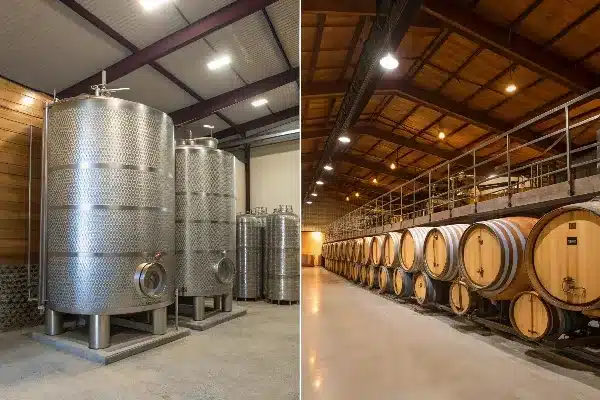
7. Step‑by‑Step: How to Ferment Wine in a Stainless Steel Tank (Hands‑On Walkthrough)
1. Sanitize the tank
Use PAA 200 ppm for 10 minutes. Stainless steel prevents pitting, so caustic cleans fast.
2. Fill with must
Cool juice to target fermentation temperature—14 °C for aromatic whites, 26 °C for robust reds.
3. Inoculate and monitor
Yeast pitch 20 g hL, nutrients at ¼ sugar drop. Log °Brix twice daily. The primary fermenter should show steady CO₂ flow.
4. Control fermentation
Dial the cooling jacket. Conical stainless steel fermentation tanks pull solids to the cone—racking valve one foot up leaves lees behind.
5. Secondary fermentation / aging
When dry, rack to a clean tank or barrel for malolactic. Hold 18 °C. Stainless steel shines here—tank walls hold the heat of secondary fermentation evenly.
6. Stabilize and clarify
Cold crash at –2 °C for a week. Bentonite fining optional. Filter to 0.45 µm for shelf stability.
Need a visual? Our stainless steel wine fermentation tanks page has schematics, volume charts, and CIP flow diagrams.
Key factors for smooth runs: keep yeast healthy, watch cap temperature, and purge fittings. Follow these and you’ll make good wine every batch.
8. Cleaning, Passivation, and Less Maintenance Over the Long Haul
A shiny tank today means clean flavors tomorrow.
- Regular cleaning: Hot rinse → alkaline wash → acid neutralize. CIP cycle totals 30 minutes—half that of wood vats.
- Passivate annually: Citric acid 4 % at 60 °C for 30 minutes rebuilds the chromium oxide layer—boosting corrosion resistance.
- Simplify the cleaning: Spray‑ball heads spin 360°, scrubbing the entire fermentation tank interior without manual entry.
- Audit valves quarterly—replace gaskets showing crazing to avoid bacterial growth.
Compared with wooden barrels, stainless offers advantages of corrosion resistance and easy to clean welds, saving 120 labor hours per 100 kL of capacity each year.
See automated CIP skids on the brewing equipment page—they retrofit to wine lines with minimal piping changes.
9. Scaling Up: Choosing the Right Stainless Steel Wine Tank by Style and Production Goals
Growth is thrilling—but choosing the wrong stainless steel tank size can tie up capital or starve production. Start with your crush weight, planned SKUs, and aging philosophy.
| Annual Volume | Suggested Wine Tank Portfolio | Reason |
| ≤ 15 t | Two 2 kL variable‑capacity tanks + one 1 kL fermenter | Flex for small‑lot rosé, white, and experimental red wine fermentation |
| 15 – 60 t | Four 5 kL conical stainless steel wine tanks + two 10 kL closed‑top tanks | Split white and red; in‑tank cooling zones handle heat load |
| 60 t + | Modular 20 kL jacketed cylinders on skids, paired with 5 kL “seasoning” tanks | Scale juice handling while keeping blends nimble |
Tanks are ideal when they feature cone angles ≥ 60° for easy lees removal, manways sized for pomace shoveling, and dimple jackets to spread coolant evenly around the tank. Remember to verify ceiling height—10 kL units top out near 5 m including fittings.
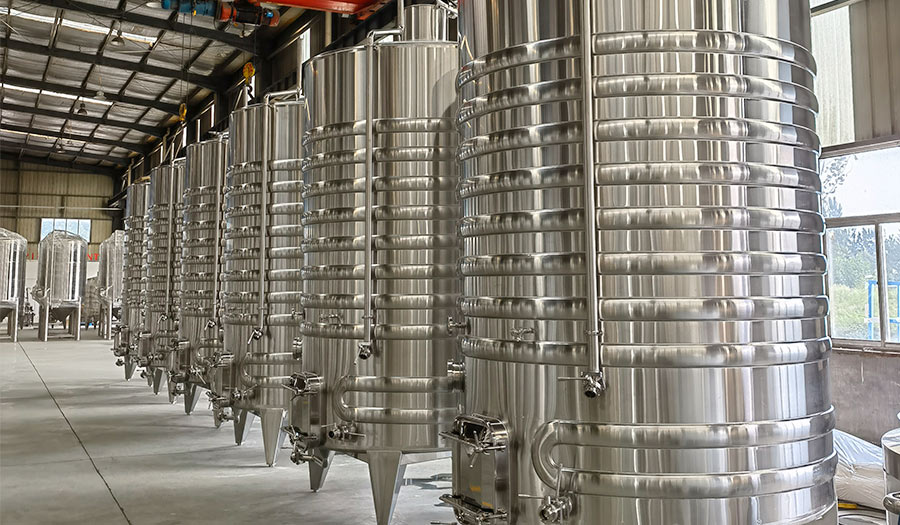
10. Troubleshooting Stuck Ferments, Sulfur Notes & Other Headaches
| Problem | Likely Cause | Quick Fix |
| Stuck fermentation (Brix flat, temp cool) | Low nutrients, yeast crash, cold core | Warm must to 20 °C, add DAP 30 ppm, gently rouse cap |
| Rotten‑egg H₂S smell | Nitrogen deficit, reductive fermentation process | Aerate briefly, add 0.3 ppm copper citrate, keep temperature stable |
| Excess VA or ethyl acetate | Over‑oxygenation, dirty hoses, wild microbes | Tighten seals, sanitize lines, drop fermentation temperature 2 °C |
| Browning in white wine | Oxidative handling, high pH | Dose 40 ppm SO₂, rack under inert gas, chill |
| Bacterial growth ring at liquid line | Poor cleaning, warm stored tank | Clean and maintain with caustic + PAA, store dry |
“Control the variables and yeast will reward you. Stainless steel tanks give you levers to pull before problems snowball.” — Tessa, South Africa winemaker
More deep‑dive SOPs live in brewing equipment knowledge base.
11. Frequently Asked Questions
How long can I age wine in a stainless steel tank?
You can age 3 – 12 months with no flavor pickup. Inert gas blankets and cool storage prevent oxidation.
Do stainless tanks work for pet‑nat or sparkling wine?
Yes—pressure‑rated vessels handle CO₂ and let you monitor fermentation without losing fizz.
What grade of stainless is best for corrosive must?
304 works for most wine production, but 316L offers extra corrosion resistance when acidity is high.
Can I retrofit a cooling jacket to an older tank?
Clamp‑on glycol panels exist, but purpose‑built tanks with built‑in jackets offer tighter control and easier CIP.
Is cleaning really faster than with wooden barrels?
Absolutely. A single operator can CIP a 10 kL fermentation tank in 25 minutes—compare that with two hours to steam and swell 45 barrels.
Will stainless strip tannin from red wine?
No—stainless is neutral. Tannin extraction comes from skin contact time and temperature, not the vessel wall.
12. Key Takeaways
- Stainless steel fermentation delivers repeatable quality, simpler hygiene, and lower long‑term costs.
- Precise temperature control during fermentation preserves fruit and minimizes faults.
- Headspace management and inert gas protect against oxidation—crucial for delicate aromatics.
- Regular cleaning and annual passivation keep your investment running for decades with less maintenance.
- Scaling? Match volume of wine to tank portfolio; modular designs let you grow without downtime.
- Need turnkey help? Our global team installs, commissions, and trains crews on every continent—reach out and let’s craft high‑quality stainless steel solutions that fit your cellar.
Ready to elevate your cellar? Visit the stainless steel wine fermentation tanks page and click Get a Quote—we’ll reply within 24 hours.

